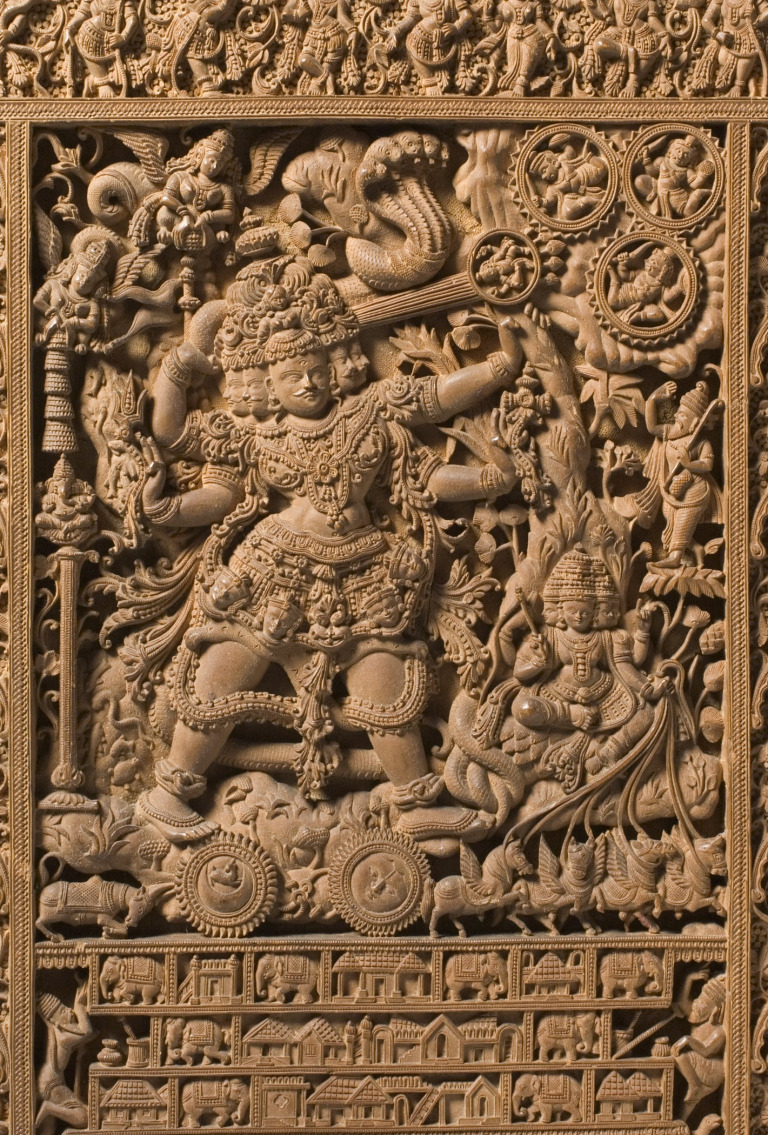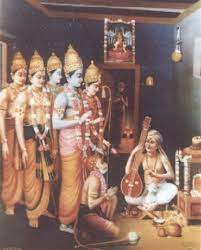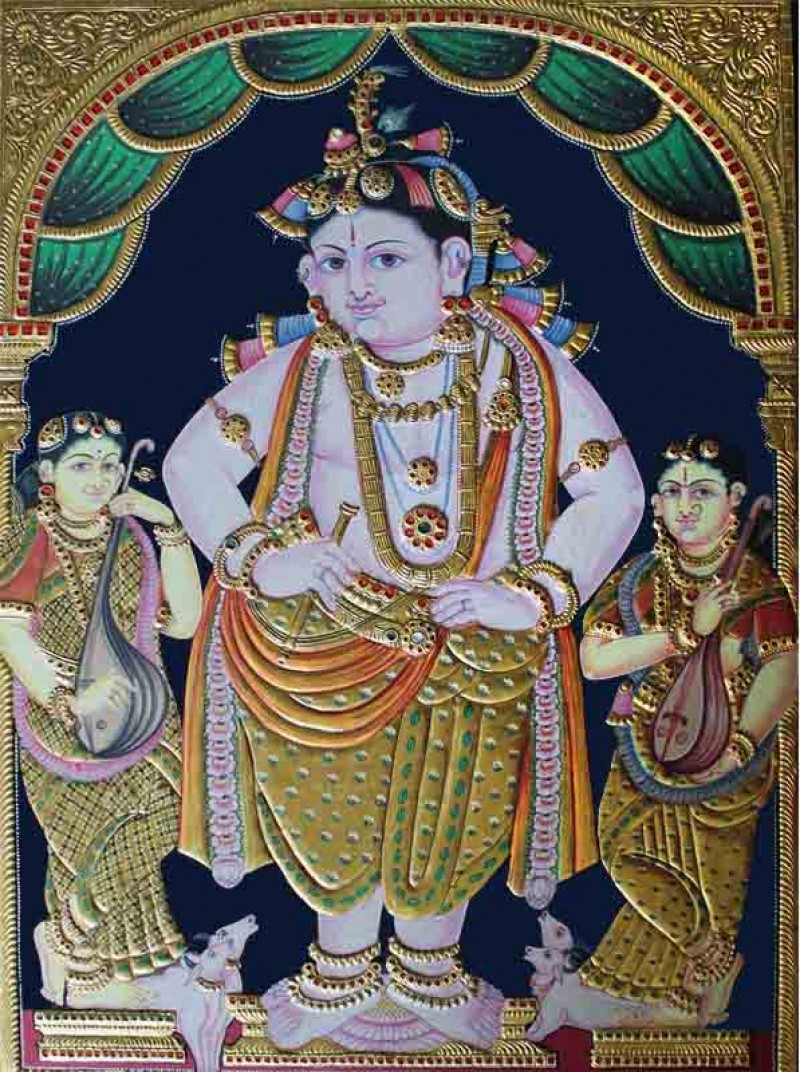[simple-author-box]
वटाधोनिवासं महाट्टाट्टहासं महापापनाशं सदासुप्रकाशम् ।
गिरीशं गणेशं महेशं सुरेशं शिवं शङ्करं शम्भुमीशानमीडे ॥
vaṭādhonivāsaṃ mahāṭṭāṭṭahāsaṃ
mahāpāpanāśaṃ sadāsuprakāśam ।
girīśaṃ gaṇeśaṃ maheśaṃ sureśaṃ śivaṃ śaṅkaraṃ śambhumīśānamīḍe ॥
I pray to You, Shiva, Shankara, Shambhu, the One who has his abode under a Vata (Banyan) tree, Who possesses an immense laughter, Who destroys the greatest sins, Who is always resplendent, Who is the Lord of Mountains, the ganas and demi-gods, Who is the great Lord, and Who is the Lord of everyone.
Prologue:
In these times, as one’s thoughts drift off in the world of music, ragas with a haunting or beseeching tonality resonate instantly to us. The raga Margadesi and the composition ‘mangaladevate paradevate” was one such instance as we saw in a previous blog. Yet another instance is the raga Kusumakara which is the raganga raga/ head of the Mela 71, with the heptatonic equivalent being the raga Kosalam. The raga is a melody bearing the notes S R3 G3 M2 P D2 and N3 and having the vivadhi combination R3G3. Let’s jump right away into the raga and the exemplar composition.
The melodic canvas of the raga:
The raga is an outcome of the theoretical derivation of Venkatamakhin (circa 1620AD) himself when he conceptualized the 72 mela scheme by a permutation/combination exercise. But realising that it would just be a theoretical exercise, he stopped short in not naming or cataloguing all of them in his Caturdandi Prakashika (CDP). It was left to Muddu Venkatamakhin later in circa 1750 AD when he created the “Ragalakshanam” or what we today call as the Anubandha to the CDP, when he proceeded to document every one of the 72 mela ragas and named every one of them. While purva prasiddha ragas like Malavagaula, Sankarabharana or Kalyani were taken and anointed as head of the respective clans/mela vargas, very many “derived” melodies came to be created by him to represent the rest of the melas. Kusumakara is one such derived melody which was invented to represent the 71st Mela carrying the notes S R3 G3 M2 P D2 and N3.
The raga compendium “Ragalakshanam” being a tabulation of ragas, was one of the heirlooms of the Dikshita family with Ramavami Dikshita himself undergoing tutelage under Venkata Vaidyanatha Dikshita a descendant in the lineage of Venkatamakhin/Muddu Venkatamakhin. And duly Muthusvami Dikshita came to inherit the same. Legend has it that Muthusvami Dikshita upon the request of the Tanjore Quartet commenced a project to invest every one of the 72 melas, an exemplar composition, so that they get instantiated with flesh and blood. And his kriti “Kusumakara Sobhita” in the raga Kusumakara is one such solitaire available in this raga, documented in the Sangita Sampradaya Pradarshini (SSP). It has to be mentioned that had it not been for Muthusvami Dikshita, much of the 72 mela raganga ragas derived by Muddu Venkatamakhin would have remained in the manuscripts, consigned to the dustbin of history and long forgotten.
On the authority of the Ragalakshanam, the compendium that he in turn inherited, Subbarama Dikshita provides the nominal arohana – avarohana krama of the raga as under:
Arohana : S R3 G3 M2 P D2 N3 S
Avarohana: S N3 D2 P M2 R3 G3 S
Attention is invited to:
- the vakra avarohana prayoga PMRGS which is invariably rendered embellished with the jaru gamaka as PM\RG\S. It may be pointed out here that MRGS is a standard descent progression for Melas 69,70,71 and 72. It is to be noted that dRS or SRS are exceptionally seen in the exemplar composition of Dikshita, which may not accord with the stipulated RGS prayoga.
- It is also commented in the SSP that PDS is alone seen in the gitam whereas the phrase PDNS is sanctioned in the arohana krama. As we will see the exemplar composition of Dikshita PDNS is not seen. PND and PDS is alone seen used by him. Given that PMGRS is forbidden, the only lineal combination used by Dikshita is SNDP, eschewing
The Composition:
pallavi
bhAvayE-aham – I meditate upon
kusumAkara SObhita SrIpura gEhaM – the One, whose abode is Sripura (Tiruvarur) resplendent with the KusumAkara vimAna
kumbhaja guru guha nataM – the one propitiated by Agastya (the pitcher-born) and Guruguha,
Anupallavi
hasana jita tripuraM – the one who vanquished the Tripuras with a mere smile/laugh,
ava nata mura haram – the one saluted by Vishnu (slayer of Mura),
abja SEkharaM – the one with the crescent moon on his forehead
karuNAkaraM – the abode of compassion,
haram – the destroyer (of the universe),
bhasita-uddhULana dharaNaM – the One who bears the sacred ash (sprinkled on his body),
pannaga valaya-AbharaNaM – the One who has snakes entwining Him as his adornments,
asama-astra garva haraNaM – the One who vanquished the pride of Manmatha (the one with odd-numbered, i.e. five arrows),
aga rAja sutA ramaNam – the Lord of Parvati, the daughter of the king of mountains.
Some Notes on the composition:
The composition is replete with a number of lyrical phrases rarely encountered in other compositions of Dikshita.
- Dikshita’s colophon “guruguha” as well as the raga name explicitly appear in the lyrics.
- Vakra prayogas abound. Save for SNDP no other lineal prayoga such as SRGMP or PDNS is found used in the raga by Dikshita.
- Jumps, bends, turns and twists are seen used such SM, SP, SD, PS, PND, PSR, SDPM, DRS etc
- Though the lyric “kusumAkara sObhita” is interpreted otherwise, it actually alludes to the specific architectural style of the Tiruvarur temple vimana (canopy over the sanctum sanctorum) which is “kusumakara vimanam”. Dikshita has alluded to the architectural style of the temples in his compositions as under:
- “sOmAccanda vimAnastam” – “Sri Sundararajam” in Ramakriya alluding to the Somacchanda vimana style of the temple canopy there.
- “pranavAkAra divya vimana” – “Ranganayakam” in Nayaki referring to the architectural style of the Srirangam temple canopy.
- “susObhita-utpalAvataka stitham” – “baktavatsalam” in Vamsavati- referring to the utpalAvataka vimanam style of the temple at Tirukkannamangai
- The ksetra of the kriti is obviously Sripura or Tiruvarur and is on the Lord Shiva enshrined there. In very many kritis, Dikshita makes such a reference, for example the kriti” Sri Muladhara Chakra” and “Sri Valmikalingam” wherein “sripura” is used by him to connote the stala, being Tiruvarur.
- Dikshita however does not mention in the kriti whether he is propitiating Lord Tyagaraja or Lord Valmikesvara, which are the main forms enshrined in the temple. He only addresses the Lord in generic terms in this composition.
- The other mela raga/raganga that Dikshita has dedicated a kriti for Tiruvarur is the kriti “Viravasanta Tyagaraja” being in Mela 24 being Viravasanta, apart from Sriraga on which we had a blog post earlier on.
- Dikshita makes a number of allusions in this composition, for instance:
- Sage Agastya through the lyrical phrase “kumbhaja”; (See Foot note 1)
- the destruction of the Cities of Tripura by a mere laugh/smile of Lord Shiva even before he shot the arrow upon Lord Brahma’s intervention (“hasana jita tripuram”);
- Lord Shiva donning the sacred ash – “bhasita-uddhULana dharaNaM”;
- the allusion to Kama through the reference “the one possessing odd number of arrows” and Lord Shiva vanquishing his pride as referred in the lyrical portion “asama-astra garva haranam”;
- “pannaga valayAbharanam“- is again reminiscent of “vAsuki valayE” ( “mArakOti kOti lAvanya” in Arabhi) and “vAsuki pramukhAbharanam” (“srI mAtrubhUtam” in Kannada)
- And needless to add that in the second madhyama kala sahitya line “asama-astra garva haraNaM | aga rAja sutA ramaNam ||” he narrates pithily the events leading up to the birth of Lord Subramanya/Guha.
All these allusions/epithets are unique and not encountered as such in other compositions of Dikshita. The reference to Lord Shiva as the destroyer of Tripura was also seen in an earlier blogpost.
9. The word “abja” signifying an object borne forth from a body of water has been used by him to refer to the moon (as it rises from the ocean or came forth when the Devas churned the Ocean of Milk). Dikshita has again used it to refer to the lotus (which springs forth from water) as in
- “abja karam” or the one with lotus like hands (“parimala ranganatham” in Hamirkalyani) or
- “abja mAlinIm”- One who is adorned with a garland of lotus flowers vide “hiranmayIm lakshmIm” in Lalitha,
10. The cittasvara is exquisite, pithily capturing the contours of the raga. Mark the sallies with just the madhyama and the rishabha note for 1 ½ tala avarta therein.
Discography:
Presented now is a close to the SSP notation rendering of the composition by Vidushi Vijayalakshmi Subramanian, who apart from keeping to the notation, musically extends the composition keeping within the bounds the laid down contours of the raga.
The first sangati of a line of lyric is seen to closely match the SSP notation while she extends the same musically in the subsequent sangatis and as pointed sticking to the raga core detailed in the composition. A couple of points merit further attention:
- In this rendering there are at least 3 obvious deviations from the SSP of which we need to cognizant of.
- the rendering of the lyric “hasanajita” is not “hasana,,jita” but “hasanajita,,” with the elongation ending on the M2 note.
- “tripuramavanata” should have been properly split and rendered as “tripuram- avanata” pausing at the end of “tripuram” and rendering “avanata” after a pause so as to make the lyric meaningful.
- the lyric starting for the madhyama kala sahitya is ” “bhasitOdhUlana dharanam” and not “….bharanam” as rendered.
- There is a prevalent thought that M2 must always be rendered as an anusvara of pancama and should not be intoned at its proper svarastana. In this kriti, the prati madhyama is given pride of place and has to be properly rendered at its svarastana as notated and should not approximated and rendered at the pancama svara stana/as an anusvara.
Concluding Thoughts:
The kriti reinforces an 18th century raga architectural principle for us once again. A raga should not be a theoretical scale, going simply up and down lineally. Jumps, bends, turns and twists (deviousness) or in other words vakra prayogas are de rigueur to a raga to add novelty and uniqueness to it and the derived melodies such as Kusumakara are no exception. In fact, these ragas are devoid of natural rakti and they cannot be embellished further by gamakas. Therefore, in the absence of such natural rakti due to the scalar nature of the raga/placement of the svaras/inability to impart color by infusing the notes with gamakas it becomes important that deviousness is leveraged to bring in individual color and tone to the raga. By using this key architectural construct of “deviousness”, Dikshita has reinforced and demonstrated that by resorting to this construct these so called scalar ragas can be composed in with felicity. And it is not without reason that he has developed these ragas specially in his shorter form kriti template.
Ragas like Kusumakara may not be amenable to a full-blown exposition on the concert stage or a full blown kriti with an anupallavi and elaborate carana segment, given their lack of rakti or their scalar nature as aforesaid. Dikshita’s shorter format creations can be wedged in between the renderings of the heavier raga compositions taken up for rendering, so as to provide contrast.
The shorter format kritis of Muthusvami Dikshita especially in the rare mela ragas such as Kusumakara are not heard much and certainly deserve greater air time. Hopefully performers will take notice and render them more. And I chose to present the raga and composition as, apart from the regular notes of G3, M2, D2 and N3, the R3G3 combination in conjunction with them imparts a haunting feel resonating with the spirits, thoughts and feelings that one faces these times.
And drawing upon the lyric “hasana jita tripuram‘ which is the reference to the puranic lore of Tripura samharam , I have featured in the blog header the image of Lord Shiva on a chariot with Lord Brahma as charioteer even as He prepares to shoot that fatal arrow at the cities of Tripura along with the sloka from Sivashtakam which refers to him as the possessor of great laughter.
References:
- Subbarama Dikshitar (1904) – Sangita Sampradaya Pradarshini – Republished in Tamil by Madras Music Academy (2006) -Vol V- Mela 71 Pages 1196-1199
- Dr Hema Ramanathan (2004) – ‘Ragalakshana Sangraha’- Collection of Raga Descriptions -pp 746
Foot Note:
- The reference to “kumbhaja” reminds one of the following. Dr Sitha in her seminal treatise “Tanjore as a Seat of Music” records a composition of one of Ramasvami Dikshita’s gurus Margadarsi Melattur Veerabhadrayya, who composed with the colophon “acyutavarada” or its variations. One such composition found by her in the manuscripts of the Sarasvati Mahal Library, bereft of notation and tala, in plain running lyrics, set in raga Manji runs thus.
Pallavi
mAmava jagadambikE sivapriyAmbikE
kOmalagAtrE dEvI kumbhajAnu stOtrE kuvalayadalanEtrE (mAmava)
Anupallavi/Caranas
candrakalApE dEvI sAmbhavasamlApE sakalAgamarUpE
himagiribAlE srutajanaparipAlE ramanIyagunasIlE
asyasarOjE dEvI avitasusamajE acyutavaradanujE (mAmava)









